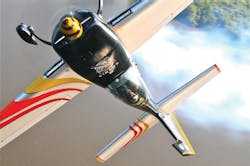Barnstorming to Business
The excitement of air shows has not changed ... and that is perhaps the only thing that has not changed with air shows in the past 25-years. For more than 100 years, air shows have been among North America’s largest spectator events.
In times past on a hot summer evening, friends could sit outside a hangar for a daily debrief and a few ice cold adult beverages and plan an air show for the following month. They could each make a few calls and a month later a family fun air show would inspire the next generation of pilots.
Today an air show takes no less than a year’s worth of detailed planning and actions by professionals with all types of skill sets.
John Cudahy. President of the International Council of Air Shows (ICAS) offers some insights.
“The economics of organizing and conducting air shows have changed significantly during the last 25 years. Not so long ago, it was possible to spend $15,000 or $20,000 and put on a world-class air show. Today, a single performer can sometimes charge that much for their performing fee.
“Increases in fuel prices and insurance premiums are driving up costs, but air shows have also become larger, more complex, and more expensive to organize and conduct. The good news is that the increased cost of running an air show has made air show event organizers more organized and professional. The financial and safety risks are too high to take casually, as the industry was 25 or 30 years ago.
“From marketing, sponsorship, and ticketing to air/ground operations, logistics, and crowd management, air show professionals are exponentially more sophisticated in their overall event management skills than they were just a few years ago.
“The last quarter century has been marked by the emergence of corporate sponsors as a key player in the air show industry. In exchange for a platform to communicate their corporate marketing message, sponsors have provided a new and important source of revenue to air show event organizers. This additional revenue has, in turn, allowed air shows to become larger and more elaborate entertainment events.
Mid-size event: $400,000
As John indicates, costs have increased significantly. A medium-sized event will cost about $400,000 to stage, and many of today’s big shows have seven digit budgets. Ticket prices have increased very little, so support from sponsorships has become critically important.
From the sponsorship perspective, what was once a nice thing to do for the local folks has become an opportunity to market products and services to crowds from 20,000 people to over 100,000, for more than a four-hour period. Many air shows are now televised providing continuing exposure for the show and the sponsors. For less money than a 15-second TV spot a corporate sponsor can reach their target demographics in a positive and fun setting. Sponsors can also use the air show venue as a location to host customers, or as a reward for employees.
Cudahy adds; “The newest generation of sport aerobatic aircraft have fundamentally changed the civilian aerobatic performances at North American air shows. Building on the success of the Pitts Special as a special purpose aerobatic aircraft, designers have put the power of strong, light building materials to work in building aircraft that have dramatically changed the kinds of maneuvers that can be performed in air shows and at aerobatic competitions.
“Thanks to airplanes like the Extra 300, CAP 242, Sukhoi 31, Edge 540, and MX-2, an air show pilot’s ability to entertain is no longer limited by the strength of the aircraft. Tumbling maneuvers that were virtually impossible 30 years ago are now commonplace at most shows. And, as a result, air show audiences are being treated to a much more dynamic and exciting type of aviation entertainment.”
Corporate sell: Demographics
In addition to offering entertainment by the various professionals in their flying machines, air shows have had to become multi-faceted entertainment events. Shows must provide a little something for everyone. ICAS does many surveys to determine who is going to air shows. Some of those demographics may surprise ...
• 23 percent have household incomes in excess of $100,000;
• 63.6 percent have some college or are college graduates;
• women make up 40 percent of the spectator base;
• 50 percent of spectators are between 30 to 50 years of age; and
• people will travel more than 100 miles to attend a show.
Military jet teams and military static displays remain the big draws, but shows need to have civilian performers, Warbirds on static display, kid zones, food and beverages, souvenirs, and other specialty vendors.
With more than 350 air shows each year in North America, scheduling and selling the sizzle requires marketing skills and professional leadership but the late day debriefing with those cold adult beverages is still an important part of the process.
ABOUT THE AUTHOR
Bobbi Thompson is a partner in ABS Aviation Management Services, LLC a Tampa-based airport management and FBO holding company, and the executive VP of Airport Business Solutions International, an aviation consulting firm. She serves as the manager of the Minden-Tahoe (NV) Airport under a management contract, and also produces international and U.S. air shows. During her 40-year career she has completed work on more than 1,400 airports and accumulated over 3,500 hours of flight time.
About the Author
Bobbi Thompson
Bobbi Thompson operates Airport Business Solutions' Fort Myers, Florida office and provides a diverse aviation background. During her career in aviation, Bobbi has been the Owner and President of a multi-base FBO, the Director of Airports for a system of five airports, the Airport Manager of another general aviation facility, Project Manager for a series of environmental audits for the FAA, and a world record-holding pilot.
